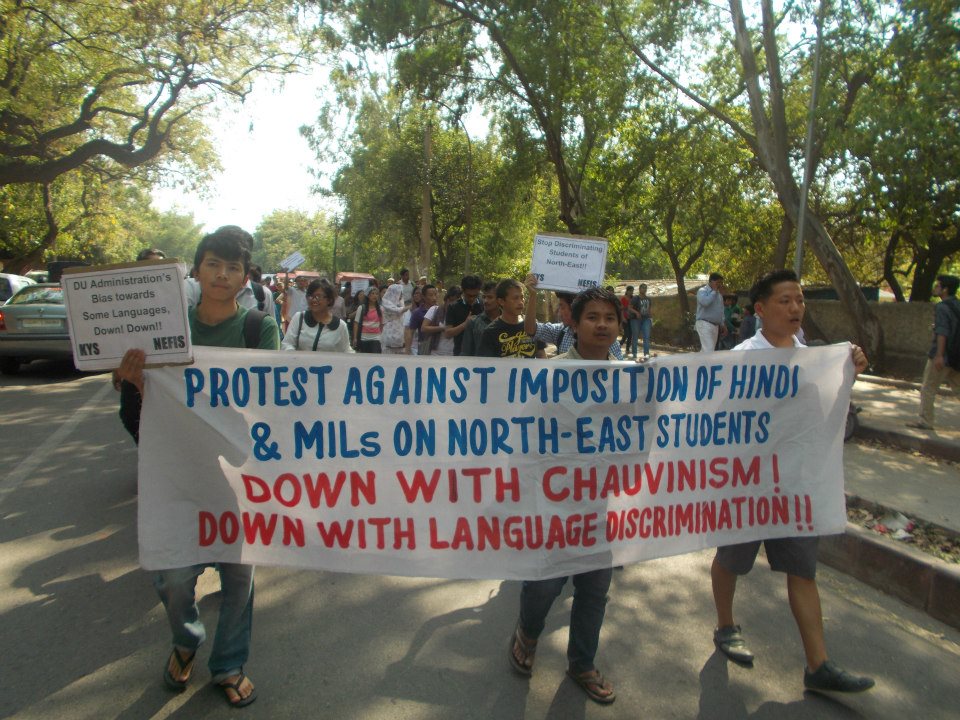Hindi imposition all over India[/caption]
Imposition of hindi in Maharashtra

The Maharashtra government’s recent decision to introduce Hindi as a compulsory third language from Class 1 to 5 in Marathi and English medium schools has triggered strong objections across the state. While the policy was presented as part of the National Education Policy (NEP) 2020 to promote multilingualism, many in Maharashtra see it as a covert attempt to promote Hindi at the cost of Marathi identity and cultur
1. Cultural and Linguistic Identity at Stake
Maharashtra has a proud linguistic heritage, with Marathi as its official language and the backbone of its cultural identity. Making Hindi compulsory threatens to undermine Marathi, especially in urban centers where migration from Hindi-speaking states is significant. The increased use of Hindi risks eroding Marathi’s presence in public life, education, and culture—threatening local entertainment, literature, and even everyday communication
2. Migration Patterns and Social Dynamics
Cities like Mumbai and Pune have long attracted migrants from North Indian states. Hindi speakers already find it easy to settle in Maharashtra, as Hindi and Marathi share the Devanagari script and many locals understand Hindi. By institutionalizing Hindi in schools, the government is making it even easier for Hindi-speaking migrants to integrate, often at the expense of Marathi. This has led to concerns that Marathi speakers are being forced to accommodate, while Hindi speakers rarely reciprocate when Maharashtrians move to northern states
3. Perceived Imbalance in Language Policy Enforcement
A major grievance is that while Maharashtra is being compelled to implement the three-language policy—including Hindi—no such enforcement exists in many northern or other non-Hindi-speaking states. In North India, public signage and instructions are often only in Hindi, making it difficult for non-Hindi speakers to navigate. This double standard fuels resentment, as it appears Hindi speakers are given undue privilege and flexibility, while Marathi speakers are pressured to adapt.
4. Business, Media, and Cultural Impact
The growing dominance of Hindi poses a threat to Marathi business, media, and culture. Marathi films and television often struggle for screen space compared to Hindi productions. If Hindi becomes further entrenched in the education system and public life, it could marginalize Marathi content, impacting the state’s creative industries and cultural expression. Such trends have already been observed, with Marathi entertainment frequently sidelined in favor of Hindi, even in Maharashtra’s own markets.
5. The Principle of Linguistic Respect and Adaptation
Maharashtrians believe that migrants should adapt to the local language as a mark of respect for the state and its culture—just as one would learn German in Germany or English in the UK. Making the local language mandatory, rather than a pan-Indian language, preserves regional diversity and fosters social cohesion. The current policy, however, appears to privilege Hindi speakers, who rarely face similar expectations elsewhere in India.
The Broader Reason
India does not have a national language, and any attempt to impose one undermines the country’s linguistic plurality. Every language in India has its own history and cultural significance. The debate in Maharashtra highlights the challenges of implementing uniform language policies in a diverse nation and underscores the importance of respecting and preserving regional languages.
“At the end, it’s about culture, pride, and identity. It’s the responsibility of every language speaker to preserve their language—but they should not force their language in a state where they are migrating. They should adapt to the language of that state, which shows respect for the territory and the opportunities it provides.”
This ongoing conversation in Maharashtra is a reminder of the delicate balance between national integration and regional identity in India’s multilingual society.
References:
1 Hindustan Times
2 The Wire
3 Times of India
4 India Today
5 Careers360
6 Business Standard
7 Daily Pioneer
This version centers the concerns of Maharashtra and Marathi speakers, clearly articulates the perceived disadvantages imposed on them, and highlights how Hindi speakers may be benefiting disproportionately from the policy.
- https://www.hindustantimes.com/cities/mumbai-news/maharashtra-eases-language-policy-amid-backlash-101750965086813.html
- https://m.thewire.in/article/politics/maharashtras-flip-flop-on-hindi-as-third-language-and-why-it-undermines-indias-linguistic-diversity
- https://timesofindia.indiatimes.com/city/pune/new-gr-on-third-language-says-hindi-not-mandatory-from-std-i-critics-call-it-eyewash/articleshow/121938888.cms
- https://www.indiatoday.in/india/story/fadnavis-defends-maharashtra-third-language-policy-raj-thackeray-opposes-hindi-2742836-2025-06-19
- https://news.careers360.com/maharashtra-hindi-mandatory-in-schools-new-third-language-policy-controversy-marathi-fadnavis-opposition-nep-explainer
- https://www.business-standard.com/india-news/education-maharashtra-hindi-language-rule-rollout-withdrawal-nep-controvers-125042201427_1.html
- https://www.dailypioneer.com/2025/india/controversy-erupts-over-hindi-language-issue-in-maharashtra.html
- https://www.indiatvnews.com/education/news/maharashtra-makes-hindi-as-third-language-in-schools-issues-revised-notification-latest-updates-2025-06-18-995155